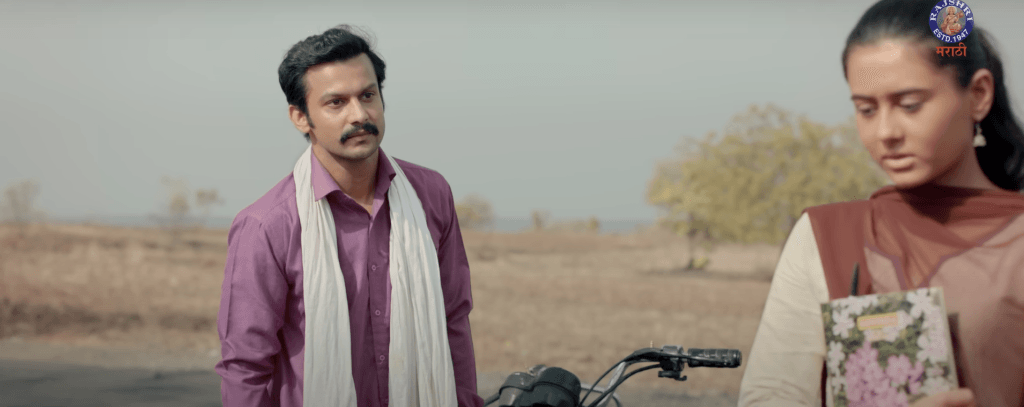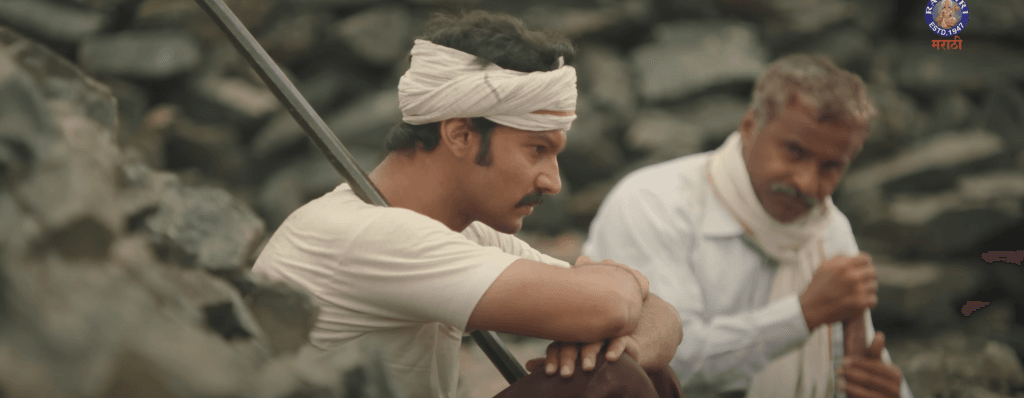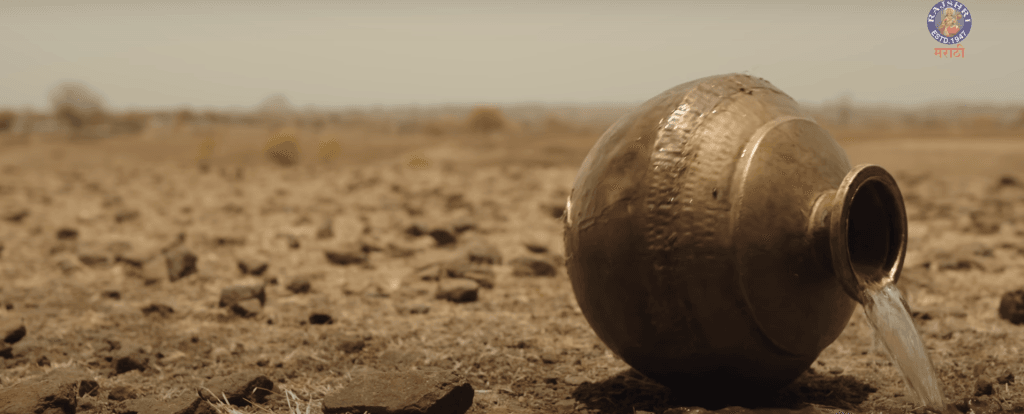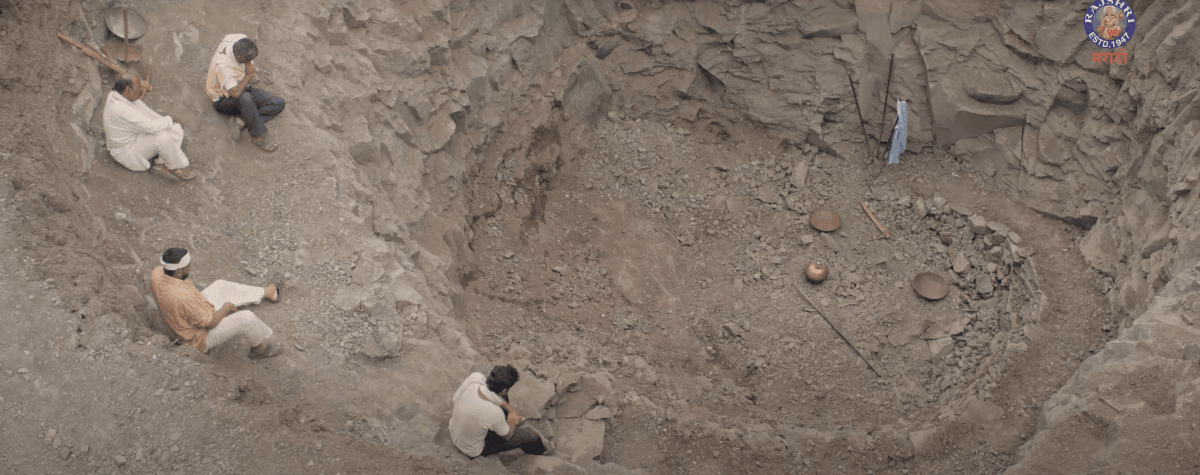Set amidst Nagdarwadi, a drought-prone village, Paani narrates the tale of Hanumant Kendre and his quest to bring water and a lease of life back to his village. Directed by and starring Addinath Kothare, the Marathi film harks back to the late 1990s and early 2000s, a phase when Maharashtra’s water table underwent a substantial downfall, migration was on the rise and the likelihood of a man getting married was bleak.
Paani, as the name suggests, is about water, and the lack of it. But that’s certainly not all that it brings to the table. It has undertones of fiction and romance but essentially draws upon the harrowing phase of 1999 in Nagdarwadi when farmers were compelled to attempt suicide or resort to alcoholism to escape the misery caused by poverty. However, there’s something more to the tale.
Coming to the mise-en-scène, the establishing shots featuring a withering land, the rural life of Marathwada, and the dust of the roads, accentuate the acuteness of water shortage in the film. The sounds of a rugged landscape in the background, particularly the blowing of dry winds, add a layer of depth to the suffering endured by villagers, making the screenplay believable and raw.
The connection between personal troubles and public issues
Remember watching the show Satyameva Jayate? That was where Hanumant Kendre made an appearance, bringing into light the acute water shortage that riddled his village, while simultaneously mentioning its impact on his personal life.

For Kendre’s character, fondly known as Babu, the task of finding a woman to get married to was as arduous as that of procuring water in the village, dried-up and parched. After Kendre finds an ‘ideal‘ match in Suvarna, their marriage is shelved by the latter’s parents when they learn about the dire situation of water shortage in his village.
Only when Kendre realises that this issue has an ill impact on his marriage prospect does he resort to dealing with and addressing the ever-urgent problem, which he didn’t pay much heed to, despite his elder brother’s request for assistance. He is now compelled to bring water cultivation projects to his village, devote his attention to ensure progress and work in collaboration with Subodh Bhave, his brother and a member of an NGO dedicated to making the village drought-free.
It is understandable why Suvarna’s parents refuse to proceed with her marriage with Babu (Kendre). What if he resorts to a practice similar to that of “water wives” prevalent in another Maharashtrian village by the name Denganmal, wherein a man marries multiple women who travel long distances to fill empty vessels with the onset of severe drought, while the first wife performs the task of cooking?
The ordeal Kendre faces reminds me of C Wright Mills and his sociological work, ‘The Promise,’ wherein he draws a connection between the personal troubles of individuals and public issues faced by society and asserts, “Troubles occur within the range of an individual’s immediate relations; they have to do with hisself and with those limited areas of social life of which he is directly and personally aware . . . Issues have to do with matters that transcend these local environments of the individual and the range of his inner life. Society and individual are thus, dialectically linked.“
Water serves not only as an elixir of life but also plays a pivotal role in marriage ties. It is understandable why Suvarna’s parents refuse to proceed with her marriage with Babu (Kendre). What if he resorts to a practice similar to that of “water wives” prevalent in another Maharashtrian village by the name Denganmal, wherein a man marries multiple women who travel long distances to fill empty vessels with the onset of severe drought, while the first wife performs the task of cooking?
Kendre’s initial cynical outlook and neglect for the cause stemmed not only from the grim natural conditions of the village. He is faced with the task of mobilising the villagers towards the cause, which is not as easy as it seems. Babu not only harbours an enduring bond with Suvarna but also with the villagers, engaging in collective labour while digging holes and wells for harnessing water, putting up a strong front against the nexus between local politicians and goons who build vote banks based on hollow promises guaranteeing free access to water.
Why does Paani fail to make a splash?
Do you recall the song “Toofan Aalaya” featuring Aamir Khan, attributing attention to the drought-like conditions in Maharashtra’s villages? The film may be interpreted as a longer version of the song itself.

One drawback of the narrative is that it does not engage with systemic reasons behind the drought-like conditions. The film does not explore the cultural and religious dimensions attached to water shortage and access but presents it as linked to human rights, demanding stringent action from concerned authorities. It lags in terms of delving deeper into the toll that the crisis takes on the emotional well-being of the villagers and the turmoils they encounter right from the onset of dawn. The element of urgency is missing, which seems bizarre since water shortage is an issue that demands immediate action.
Even though the narrative sheds light on an ever-pertinent issue, it keeps moving back and forth on three aspects- the crisis inflicted upon the drought-prone village, the obstacles it creates for Kendre’s marriage and his relentless efforts to procure access to water, by hell or high water. The screenplay thus gets repetitive, predictable and monotonous at times, lacking depth and layers. However, despite its shortcomings, Paani does not merely present a straitjacket take on the issue of water scarcity. It is not solely a deep-seated environmental problem but is intricately tied to networks of marriage and kinship.
A double burden for women
Paani commences with the initial shots focusing upon women walking barefoot across rugged terrains, carrying the burden of both the water pots and a threatened livelihood on their heads. The narrative paints an image of the double disadvantage women are subjected to when water becomes scarce, performing unpaid labour, exposed to a heat stroke, panicking when the pot slips off their head and the water is absorbed by the dry land, while helplessly attempting to gather all the water that’s left.

History is replete with instances of men waging battles to “win” women, reducing them to objects. This battle for water is also ignited to secure one’s marriage to the woman of one’s choice, with an environmental crisis as the backdrop. Unlike the director of the Paani, who believes that the film throws “a unique perspective on love,” it is evident that while Babu is projected as a hero-like figure with a new-found conscience, Suvarna is reduced to a passive character who must wait for Babu to resolve the issue, serve the cause and return to marry her. However, if this is a choice Suvarna makes after knowing all the alternatives, perhaps we as feminists cannot question her decision.
In essence, the narrative describes the village, marked by scarcity of water and the possibility of Kendre’s marriage, in deep water. The film can thus be understood as both a tool for social messaging and tracing the course of action a man pursues when water scarcity becomes an inevitable reality.
About the author(s)
Syeda Shua Zaidi is a student of B.A. (Hons) Sociology, at Miranda House. Passionate about poetry, filmmaking, heritage walks, social work and all things vintage, you would find her reading the works of Murakami, Khaled Hosseini and Agatha Christie while treating herself to a cup of tea. Firmly a believer of "disagreements are welcome, disrespect is not".






You’r nailing it.